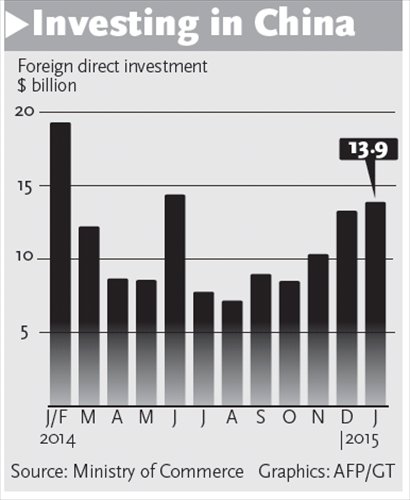Biggest FDI rise in 4 years
Investment up by 29.4 percent y-o-y in January

Foreign direct investment (FDI), a gauge to show the flow of capital, grew at the fastest rate for nearly four years despite slower economic growth in China, official data showed on Monday.
The FDI in January soared by 29.4 percent from a year earlier to $13.92 billion, with most of it going to the services and high-end manufacturing sectors, the Ministry of Commerce (MOFCOM) said.
FDI in the services sector was $9.18 billion, up 45.1 percent year-on-year and accounting for 66 percent of the total FDI, the ministry said, adding that 28.4 percent of FDI went to high-end manufacturing.
The top 10 investors, who accounted for 96.5 percent of the January figures, were led by Hong Kong, South Korea and Singapore.
"The share of investment shows us that the FDI has shifted from manufacturing to services, which shows the latter has huge potential, especially since China is losing its competitive edge on labor-intensive manufacturing due to the rising costs of labor, land and environmental costs," JP Morgan Chief China Economist Zhu Haibin said Monday in a note sent to the Global Times.
More free trade zones, which are set to allow yuan convertibility and fewer restrictions on FDI in China, may have helped with the FDI increase, Lu Zhengwei, a Shanghai-based chief economist at Industrial Bank Co, told the Global Times on Monday, citing the fact that last year, the free trade zones were extended to Guangdong and Fujian provinces and Tianjin after the approval of Shanghai in 2013.
"We predict China's FDI will be stable in 2015," Shen Danyang, spokesperson of the ministry, said at the Monday press conference, adding that the government will lower the entry level, increase the transparency of the investment environment and further open the market to attract overseas investment. A report released by the United Nations Conference on Trade and Development in late January said that China replaced the US as the top destination for FDI last year, with a figure of $119.6 billion, a growth of 1.7 percent from one year earlier.
However, Shen said the overtaking of the US was to some extent contingent, as the falling inflows in the US were mainly caused by a deal between US-based Verizon Communications Inc and its British partner Vodafone.
Earlier ministry data showed that the FDI in December grew by 10.3 percent year-on-year, but the growth of FDI in 2014 was 1.7 percent, the slowest pace since 2012.
Shen said China's foreign trade still faces uncertainties as the global economic recovery remains fragile, and growth in China is on a downward trend.
"The pressure in China mainly lies in the housing market and domestic consumption, which are not going through a big investment fever," Bai Ming, a research fellow at the Chinese Academy of International Trade and Economic Cooperation, told the Global Times on Monday.
"But we do have confidence of seeing positive growth in FDI this year, and hope the figure could stay in line with the growth of China's GDP," Bai added.
The latest data from the General Administration of Customs showed that exports fell 3.2 percent in January year-on-year, compared to growth of 9.7 percent in the previous month, while imports dropped by 19.7 percent, the lowest since June 2009, resulting in a trade surplus of $60.03 billion.
The trade surplus is brought by the global economy structure, and the data in January could not prove that the trade surplus in 2015 will increase sharply, Shen from MOFCOM said. "We are confident to expect a growth in foreign trade for the whole year."
In November, the State Council released a file advocating market-oriented import policies in stronger language than before, including measures such as encouraging the import of advanced technologies and equipment, and stabilizing the import of resources.
Nonetheless, China's outbound direct investment (ODI) reached $10.17 billion in January, up 40.6 percent from a year earlier, the ministry said. China reached a record $102.9 billion of ODI last year.
Shen also said there are concerns of deflationary risks in China, but the world's second largest economy is not facing that danger now.